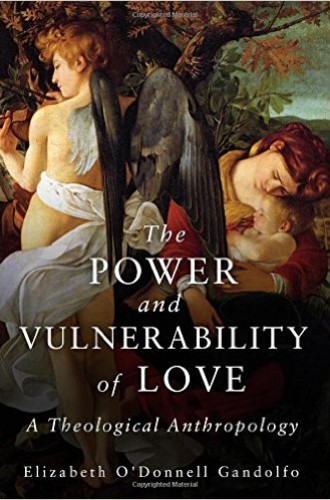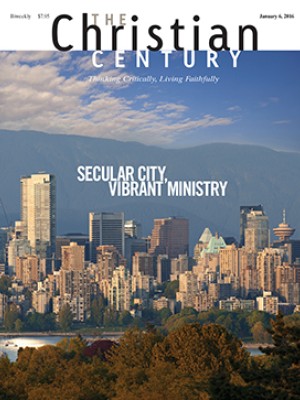God in weakness
If Jürgen Moltmann and Brené Brown collaborated on a book, what might emerge is something like Elizabeth Gandolfo’s The Power and Vulnerability of Love. The volume is framed as a theological anthropology, and it is that: a consideration of what human beings are, with reference to who their creative, redeeming, and sustaining God is. But this, Gandolfo’s first book, is not just an anthropology. It also offers a statement about God that is its more daring and abidingly important gift.
Perhaps this is true of all theological anthropologies: in order to say something insightful about the kinds of creatures human beings are, one must say something about who God is, and because God is more interesting than we are, the theologian’s claims about divinity will always be the most arresting part of the project.
Read our latest issue or browse back issues.
Gandolfo wants to offer an account of God’s vulnerability, and she comes to that account via a discussion of human vulnerability as it is crystallized in childbirth and motherhood. Many of us middle-class Westerners have found ways to fend off the reality of our vulnerability, but certain experiences—old age would be another—puncture the protections we’ve developed and show us our fundamentally vulnerable state. Motherhood exposes the way human beings are vulnerable to “bodily harm, suffering, and, ultimately, our unavoidable mortality.” Mothers and babies can die in childbirth; some mothers are wrecked by “the living death of . . . obstetric fistula”; and motherhood exposes human vulnerability in the interdependence of mother and child, in their intersubjective “relational existence.”
Gandolfo is sensitive to the wide variations among mothers’ experiences, and she grounds her depiction of motherhood in stories from different parts of the globe and from different points on the spectrums of health and socioeconomic power. Though keen to discuss the intense and traumatic vulnerabilities of poor mothers and mothers who live in circumstances of dramatic political instability, Gandolfo nonetheless takes seriously the vulnerabilities of mothers in privileged circumstances. She takes seriously the middle-class American mother’s feeling that she is always doing something wrong, that she is somehow failing and that because she is failing, her child will too.
Gandolfo doesn’t need doctrine about God to say any of that; she just needs feminist sociology. But her descriptions of maternity yield a way to say something about God. The theology she limns is aptly paradoxical: she retains a notion of divine invulnerability while also inscribing the incarnate God so fully in human vulnerability that it becomes impossible only to assert God’s invulnerability—even as human vulnerability demands the invulnerability of God.
The first move Gandolfo makes—her defense of divine invulnerability—involves her in a quarrel about Christian theology’s traditional insistence that God is immutable and impassible. Some feminist theologians and some theologians who put the Shoah at the center of their study have proposed that it is indefensible to describe God as One who neither suffers nor changes. In Gandolfo’s paraphrase, “How can a loving God remain unaffected by or invulnerably controlling of a history in which so much suffering and death has destroyed so many human beings?” Especially in light of the maternal horrors she sketches—the Salvadoran woman watching the murder of her child, the enslaved woman trying to protect her daughter from rape—Gandolfo takes this critique seriously. But she argues that it is precisely these horrors, precisely human vulnerability, that demands a doctrine of divine invulnerability.
God’s invulnerability is not, Gandolfo says, that of a “distant monarch . . . who lacks compassion for His subjects, their pain, and suffering.” Instead, God’s invulnerability is the “dimension of divinity that offers vulnerable human beings stability of identity as imago Dei and an unchanging love on which to draw for courage, resilience, and resistance, even in the face of horrors.”
In other words, what human beings need from the divine is not only solidarity, compassion, and responsiveness; we need a kind of surety, a kind of nonnegotiable Being who is invulnerable to the very horrors we suffer.
This is a claim about us as much as it is a statement about God. Or, rather, it is a statement about God articulated with the way God created us to be: what we most elementally need in the face of horrors is not company, but the kind of bravery one can draw from and the refuge one can take in something that—Someone who—will not be buffeted by the horrors. Were this not the case, the image of God within us could be eradicated. It cannot. It is inviolable precisely because the God it images is invulnerable.
But if that is all we say, we cease to have Christmas. The second person of the Trinity takes on human vulnerability; that is by definition what God’s incarnation is.
“The invulnerability of divine love’s free self-expression,” writes Gandolfo, “is most fully manifested in creation when it does . . . what it is in love’s essence to do—enter into vulnerable relation with the beloved, even when to do so seems to contradict the invulnerability of the divine essence.” Gandolfo explores this by locating the second person of the Trinity inside a narrative of maternal vulnerability—that is, inside childbirth, which was “a terribly vulnerable time for both Mary and Jesus.”
Gandolfo’s account does not focus on the abstractions of kenosis, the finitude of embodiment, and so on. Rather, through a startling and granular description of childbirth, she shows what was at stake in the way the Christian God came to Earth. The Christian God did not plunk down from the heavens in the form of a swan, or fall into a virgin’s lap as a shower of gold coins. The Christian God came to Earth the way the rest of us do—with inescapable vulnerability: “The bloodiness of [Mary’s] labor could have ended differently. Love incarnate did not pass into the world through Mary’s womb like a ray of light.”
There were risks. The umbilical cord could have tangled around Jesus’ neck and choked him. Mary could have hemorrhaged. She could have become eclamptic. Had she died in childbirth, who would have nursed her son and tended him? Following Martha Nussbaum’s observation that “lack of limit is itself a limit,” in Mary’s pregnancy and Jesus’ birth Gandolfo considers afresh the question of how an infinite and invulnerable God can be said to have wholly entered into human existence. So Gandolfo has given us an anthropology, yes, but a Christology, too.
A pastorally urgent question underpins Gandolfo’s work: What do we most desperately need from God, and can we get what we most desperately need if, for God, suffering goes all the way down? Of course, theology shouldn’t emerge wholly from an examination of ourselves. But some examination of ourselves must be an ingredient of theology. There are things about us that are completely puzzling, and our puzzlement is illumined when we think about it alongside thinking about God.
Love is a puzzle, including the love Gandolfo describes feeling for her babies and the sorrow she feels about the suffering she knows will come to them. It is a puzzle we cannot satisfyingly address only by saying something about the lover or the beloved.
What is it about a baby that makes her mother love her so much? To answer that question, we do need to say something about the lover and the beloved—the mother and the child—but we also need to say something about the nature of love itself, and about God. And then our thinking about maternal love, or any other kind of love, opens avenues for thinking about God, precisely because we claim imago et similitudo Dei. As exemplified by Gandolfo’s insistence that we proclaim God’s invulnerability at the same time that we assert the incarnate Lord’s necessary vulnerability, the puzzling things about us will be illuminated when we think about God, and this may in turn help us to think about God better.






